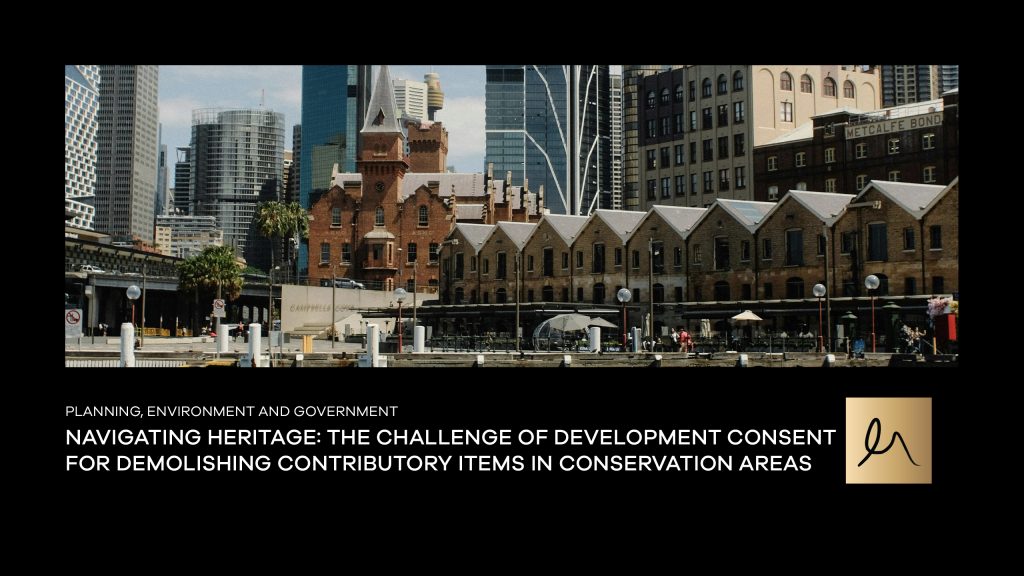A recent decision of the Land and Environment Court demonstrates the difficulty in obtaining development consent to demolish a contributory item within a Heritage Conservation Area.
In the case of 26 Salisbury Pty Ltd v Woollahra Municipal Council [2024] NSWLEC 1119, the Court considered a DA for the demolition of an existing dwelling house and construction of a new residential apartment building comprising three apartments with basement parking, landscaping, and site works at 26 Salisbury Road, Rose Bay. The site was located within the locally significant “Balfour Road Heritage Conservation Area” (HCA) as listed in the Woollahra Local Environmental Plan 2014 (WLEP).
The existing dwelling on the site was described as an “Inter-war Bungalow” and identified under the Woollahra DCP 2015 (DCP) as a “contributory item” within the HCA. The DCP defines contributory items as items that are not individually listed as heritage items but still add value to the character of the HCA.
The DCP (Development Control Plan) uses the term “contributory items” to refer to items not explicitly marked as heritage items on their own. However, they still add value to the Heritage Conservation Area (HCA). In simpler terms, even though these items aren’t singled out for heritage protection, they help give the heritage area its unique look and feel, enhancing its historical ambience.
The threshold issue for the Court to determine in this case was whether the impact of the proposed demolition on the heritage significance of the HCA was acceptable. The Court held that the impact was not acceptable.
The Court applied the planning principle established in Helou v Strathfield Municipal Council [2006] NSWLEC 66. The principle suggests the Court should approach impact assessment by way of the following six (6)questions:
- What is the heritage significance of the conservation area?
- What contribution does the individual building make to the significance of the conservation area?
- Is the building structurally unsafe?
- If the building is or can be rendered structurally safe, is there any scope for extending or altering it to achieve the development aspirations of the applicant in a way that would have a lesser effect on the integrity of the conservation area than demolition?
- Are these costs so high that they impose an unacceptable burden on the owner of the building? Is the cost of altering or, extending or incorporating the contributory building into a development of the site (that is within the reasonable expectations for the use of the site under the applicable statutes and controls) so unreasonable that demolition should be permitted?
- Is the replacement of such quality that it will fit into the conservation area?
Applying these questions to the case, the Court discounted the applicant’s aspirations for the site and instead considered that enlarging the existing dwelling or introducing a second dwelling or dual occupancy were “conceivable ways to intensify the utilisation of the site without demolishing the existing dwelling”. The Court also discounted the applicant’s evidence of costs associated with retaining the existing dwelling because (in a somewhat circular argument) those costs involved scenarios that “tend to defeat the benefits of retaining the contributory building”. These are high thresholds.
Applicants seeking consent to demolish contributory items in an HCA face a very high bar. Of the ten (10) applications considered by the Court since Helou, only four (4) have been successful. In effect, councils apply a level of protection to a contributory item in an HCA equivalent to individually listed item in an LEP.
Following is a list of the cases and outcomes applying Helou.
- Trustees of Roman Catholic Church for Diocese of Maitland-Newcastle v Newcastle City Council – Dismissed.
- Fullerton House Pty Ltd v Woollahra Municipal Council – Upheld.
- Xu v Council of City of Sydney – Dismissed.
- Saunders v Hunters Hill Council – Dismissed.
- Aung v Hornsby Shire Council – Dismissed.
- Bourke v North Sydney Council – Dismissed.
- Blackmore Design Group Pty Ltd v Manly Council – Upheld.
- Tang v Hornsby Shire Council – Dismissed.
- Urbanesque Planning Pty Ltd v Singleton Shire Council – Upheld.
- Mersonn Pty Ltd v Woollahra Municipal Council – Upheld.
Consult with Legal Experts for Heritage Law Experts
Understanding the legal framework is essential for developers and property owners navigating the complexities of Heritage Conservation Areas. Before proceeding with plans that involve modifying or demolishing contributory items, it is necessary to seek specialised legal counsel. Engaging with solicitors specialising in environment, planning, government councils, and heritage law will provide you with crucial insights and strategic advice, ensuring compliance with all relevant regulations and maximising the likelihood of achieving favourable outcomes with the court. Contact Madison Marcus Law Firm for legal experts in heritage, planning and environmental law to safeguard your interests and uphold the integrity of our heritage sites.
MM Website Enquiry Form
Form used to capture all MM website enquires. Will be used in Monday and Mailchimp via Zapier
"*" indicates required fields







